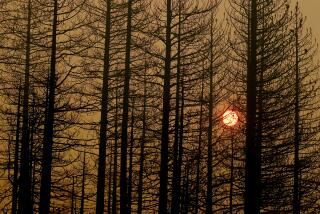Alaska’s toasty temperatures in 2014 worry observers
The biggest state in America, home to more ocean coastline than all others combined, has just set another record. This one, however, is nothing to cheer.
For the first time in recorded history, temperatures in Anchorage did not drop below zero once in an entire calendar year. In comparison, Alaska’s largest city had 14 days below zero in the 2013 calendar year and 32 days in 2012. The average is 29 days.
-----------
For the record
Jan. 3, 10:22 a.m.: An earlier headline on this article incorrectly said Alaska had a record-warm year. The state’s largest city, Anchorage, set a record for above-zero temperatures. Seven other cities in the state had record-warm temperatures as well.
-----------
At midnight Wednesday, Anchorage closed the book on its warmest year since 1926, according to the National Weather Service. The lowest temperature recorded in 2014 was zero degrees Fahrenheit on Feb. 11.
Sea ice has been disappearing. Polar bear populations have dropped. The state’s storied dog race was a musher’s mess, spurring headlines that fretted: “Warm weather, treacherous conditions — is the Iditarod in trouble?” The Bering Sea saw its warmest summer on record.
“I didn’t put my downhill skis on at all last winter, and at the moment I’m still hoping for this winter, but the prospects are not good so far,” said Henry Huntington, who lives in an Anchorage suburb and serves as senior officer for the Pew Charitable Trusts’ international Arctic program.
The Last Frontier didn’t exactly sweat through Death Valley-style temperatures. Anchorage’s 2014 annual average was a chilly 40.6 degrees or so Fahrenheit, said Richard Thoman, climate science and services manager with the weather service in Fairbanks. Still, that was well above last year’s annual average temperature of 37 degrees.
Environmentalists, policymakers and weather watchers are viewing the thermometer with concern.
“To me, the fact that Anchorage won’t dip below zero degrees in calendar year 2014 is just one more signal — as if we needed another one — of a rapidly changing climate,” said Andrew Hartsig, director of the Ocean Conservancy’s Arctic program.
Hartsig said Anchorage’s comparatively balmy weather is consistent with other long-term trends, including diminishing summer sea ice and increasing sea surface temperatures.
“These are definitely red flags that are very consistent with climate change,” said Chris Krenz, senior scientist at Oceana, an international conservation group. “These are anomalies ... that show our climate system is off-kilter.”
James E. Overland, a research oceanographer with the National Oceanic and Atmospheric Administration, would agree with the off-kilter part. But he would add mysterious to the mix, too.
Overland argues that Alaska’s very cool heat wave is not evidence of climate change but rather the next stage in a long-term weather pattern that began with six years of warming in the Bering Sea and southern Alaska, followed by six cold years.
“This year, then, was the breakdown of the string of cold years,” Overland said. “What all the scientists are wondering now [is]: Is this just one warm year? Could we flip back to a cold sequence again, or is this the start of a warm sequence? ... We don’t know, and it makes a big difference.”
Especially to the Alaska pollock, which NOAA’s FishWatch website describes as “one of the largest, most valuable fisheries in the world.” Pollock don’t like really warm or really cold temperature extremes, and their food source, small shrimp, do not fare well in heat.
“We really don’t understand how these sequences occur, but they appear to be random and part of the chaotic climate system, rather than part of the global warming signal,” said Overland, coauthor of NOAA’s 2014 Arctic Report Card. “We’ve had one warm year here. Is this a sucker punch or not?”
Climate change or chaos aside, the warm temperatures are both real and worrisome.
The weather service’s Thoman notes that a calendar year in the Northern Hemisphere contains chunks of two separate winter seasons: January, February and March, and November and December.
In the last few months, the lowest temperature in Anchorage was 13 degrees Fahrenheit, recorded on Dec. 13, Thoman said.
One record Anchorage has yet to break is the longest stretch of consecutive days above zero. That record was set over 683 days in 2000 and 2001.
Still, Thoman said, “Anchorage has never had a winter when the temperature remained warm through the end of December.”
Until now.
Just before Thanksgiving, Ned Rozell, a science writer for the Geophysical Institute at the University of Alaska Fairbanks, penned an online column with the headline “Snow-starved Alaska not the normal state.”
Rozell worried that large swaths of Alaska remained “frozen, dusty and brown” through the first three weeks of November, threatening dozens of species that depend on snow cover.
“Each lovely flake joins spiked arms with others to create an air-trapping matrix above the ground surface,” he wrote.
“The ground beneath the white blanket remains a consistent 27 degrees Fahrenheit no matter the temperature above,” he continued.
“That relative warmth, the remnants of summer’s heat released as the ground freezes, allows billions of small bodies to survive winter.”
Among the species partial to snow are the bearberry shrub, yellow jackets and voles. Oil companies like it, too, said Larry Hinzman, director of the International Arctic Research Center at the University of Alaska Fairbanks.
The massive 49th state has remarkably few roads, and most of the land is accessible only by air or water. When there is frozen ground and good snow cover, he said, parts of the state “are suddenly open for travel,” for hauling supplies and exploration.
“A good snow cover,” Hinzman said, “is very important to us.”
More to Read
Start your day right
Sign up for Essential California for news, features and recommendations from the L.A. Times and beyond in your inbox six days a week.
You may occasionally receive promotional content from the Los Angeles Times.







